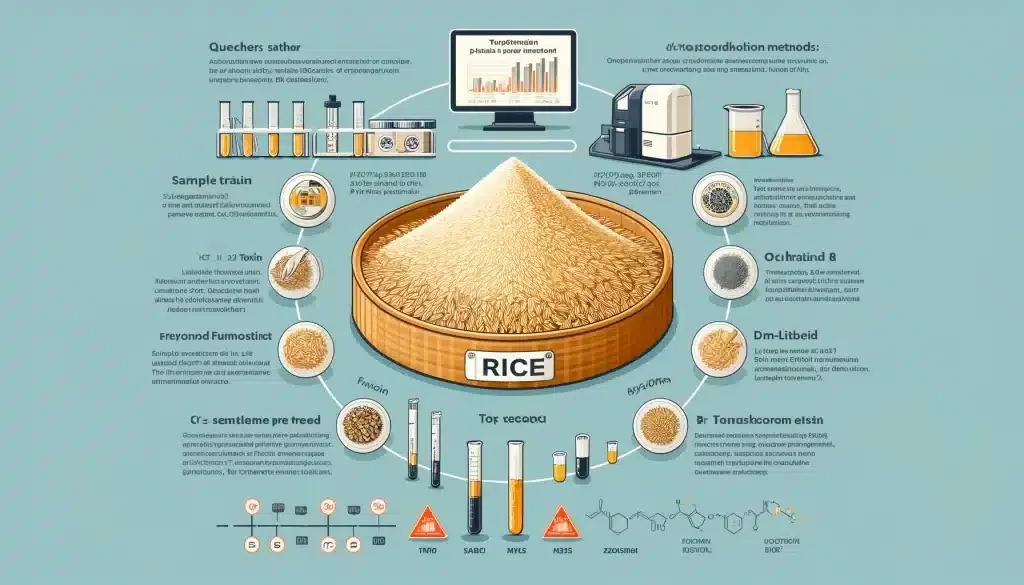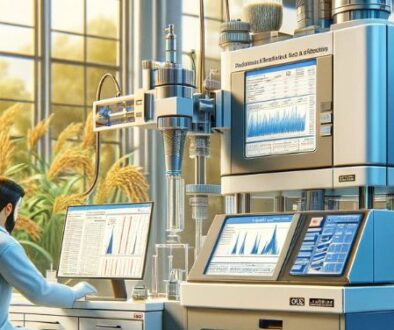Determination Of 8 Mycotoxins In Rice Based On Dispersive Solid-Phase Extraction Liquid Chromatography-Tandem Mass Spectrometry
total of 8 fungi in rice were established: HT-2 toxin, T-2 toxin, fumonisin B1, fumonisin B2, zearalenone, ochratoxin A, deoxynivalenol and aflatoxin B1 A rapid method for the determination of toxins. The recovery rates of 8 mycotoxins from 3 sample pretreatment methods based on the principle of dispersive solid-phase extraction (i.e., QuEChERS method, EMR-lipid method, and DisQuE method) were compared; the post-extraction spiking method was used to investigate the target compounds in the rice matrix. Matrix effects in LC-MS/MS analysis. The results show that the QuEChERS sample pretreatment method is not suitable for the analysis of fumonisin B1, fumonisin B2 and ochratoxin A; and the EMR-lipid sample pretreatment method cannot eliminate the presence of zearalenone and ochratoxin A in rice. matrix effect. Accordingly, the DisQuE method was used and the LC-MS/MS analysis parameters were optimized to monitor 16 pairs of ion pairs (2 pairs of ion pairs for each compound) in one injection to analyze the residual amounts of 8 mycotoxins in rice. The recovery rates of eight mycotoxins at three addition levels ranged from 70.0% to 124.1%, the relative standard deviations ranged from 0.9% to 16.9%, and the detection limits (S/N¡Ý3) ranged from 1.2 to 60.0 ¦Ìg/kg. This method is accurate, sensitive and suitable for rapid analysis of various mycotoxins in rice.
Mycotoxin Detection in Rice Overview
In recent years, the detection and quantification of mycotoxins in foodstuffs have become a critical aspect of food safety and quality control, especially in staple foods such as rice. Mycotoxins are toxic secondary metabolites produced by fungi, and their presence in food can pose significant health risks to consumers. This study focuses on the establishment of a rapid, sensitive, and accurate method for the determination of eight mycotoxins in rice: HT-2 toxin, T-2 toxin, fumonisin B1, fumonisin B2, zearalenone, ochratoxin A, deoxynivalenol, and aflatoxin B1. The study compares three sample pretreatment methods based on the principle of dispersive solid-phase extraction: QuEChERS, EMR-lipid, and DisQuE, alongside an analysis of matrix effects in LC-MS/MS.
Sample Pretreatment Method Comparison
The comparison of recovery rates for these mycotoxins across the three pretreatment methods revealed that certain methods were not suitable for specific toxins. Notably, the QuEChERS method showed limitations in the analysis of fumonisin B1, fumonisin B2, and ochratoxin A, while the EMR-lipid method was ineffective in eliminating matrix effects for zearalenone and ochratoxin A. The DisQuE method, however, stood out for its efficiency and was subsequently used in conjunction with optimized LC-MS/MS analysis parameters to monitor 16 pairs of ion pairs, allowing for the simultaneous analysis of all eight mycotoxins in a single injection.
DisQuE Method Efficacy and Optimization
The study’s findings indicate that the recovery rates of the eight mycotoxins, across three different levels of addition, ranged from 70.0% to 124.1%. This variation highlights the method’s capacity to accurately recover a wide range of mycotoxin concentrations from rice samples. Moreover, the relative standard deviations, ranging from 0.9% to 16.9%, underscore the method’s precision. Additionally, the detection limits, ranging from 1.2 to 60.0 µg/kg, demonstrate the method’s sensitivity to detect even low levels of mycotoxins, ensuring a robust detection framework.
The significance of this study lies in its contribution to food safety practices. By establishing a method that is both accurate and sensitive, the study paves the way for rapid analysis of various mycotoxins in rice, a staple food consumed by a large portion of the global population. The ability to quickly and accurately detect and quantify these mycotoxins is vital for monitoring food safety, implementing quality control measures, and ultimately protecting consumer health.
Impact on Food Safety
Furthermore, the study’s methodology, particularly the use of the DisQuE method in combination with optimized LC-MS/MS parameters, offers a practical approach for laboratories engaged in food safety testing. The detailed comparison of sample pretreatment methods also provides valuable insights for researchers and practitioners in selecting the most appropriate method based on the specific mycotoxins and food matrices they are dealing with.
Study Conclusions and Advances
In conclusion, the development of this rapid, accurate, and sensitive method for the determination of eight mycotoxins in rice represents a significant advancement in food safety and quality control. It underscores the importance of continuous improvement in detection technologies to ensure the health and safety of consumers worldwide.
For futher details of this article and research, feel free to contact our team for assistance.
Original research was done by Sun Weihua, Cao Zhaoyun, Yang Huan, Chai Shuangshuang, Qin Meiling, Chen Mingxue, Ma Youning
About ETprotein:
ETprotein, a reputable plant protein vegan protein Chinese factory manufacturer and supplier, is renowned for producing, stocking, exporting, and delivering the highest quality organic bulk vegan protein and plant proteins. They include Organic rice protein, clear rice protein, pea protein, clear pea protein, oat protein, watermelon seed protein, pumpkin seed protein, sunflower seed protein, mung bean protein, peanut protein, various of plant peptides etc. Their offerings, characterized by a neutral taste, non-GMO, allergen-free attributes, cater to a diverse range of industries. They serve nutraceutical, pharmaceutical, cosmeceutical, veterinary, as well as food and beverage finished product distributors, traders, and manufacturers across Europe, USA, Canada, Australia, Thailand, Japan, Korea, Brazil, and Chile, among others.
ETprotein specialization includes exporting and delivering tailor-made protein powder and finished nutritional supplements. Their extensive product range covers sectors like Food and Beverage, Sports Nutrition, Weight Management, Dietary Supplements, Health and Wellness Products, and Infant Formula, ensuring comprehensive solutions to meet all your protein needs.
As a trusted company by leading global food and beverage brands and Fortune 500 companies, ETprotein reinforces China’s reputation in the global arena. For more information or to get a free sample of their protein products, please contact them and email sales(at)ETprotein.com today.












